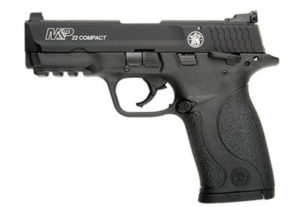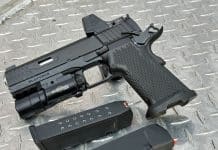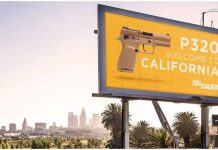
Almost two years ago, I decided to begin teaching concealed carry and basic pistol for my home state. Part of the requirements to become a State Certified Instructor was to become an NRA Basic Handgun Instructor. Up to this point, I had been in the firearms industry for ten years and had competed in several 3-gun competitions. I thought I had the basics down and knew what I was doing. I was wrong. It goes to prove that you CAN teach an old dog new tricks. One thing I learned was an extreme appreciation for the .22 LR pistol and what it can do for training. To qualify as an NRA Instructor, I had to shoot a Ruger Mark IV pistol, at 15 yards, at a 9″ target and make 16 out of 20 shots within a 6″ group. “Not too hard,” I thought. I soon realized just how out of practice I was. I wasn’t going to spend my money and time getting certified only to fail at the shooting portion, so I bought my first .22 pistol to begin practicing. I had also decided I was going to use a .22 for my students; my class price includes the use of my guns and ammo. This led me to purchase a Smith and Wesson M&P .22 Compact. This is a .22 version of the M&P Shield line. I thought as a concealed instructor, having a gun the same size and feel as a typical carry gun would help my students begin their foray into the carry world. Because I used the techniques taught by the NRA Basic Pistol course and I practiced with a .22 pistol for about a month before the class, I passed the shooting portion at the top of my class. Shooting alongside LEO and ex-military types, I was nervous, but after that class, I had confidence. This transitioned into me shooting in local IDPA matches, and I saw my once weak point in shooting become my strongest. I can’t say I’m the greatest or anything of that nature, but I usually run somewhere in the middle and now have the confidence that I can hit my target no matter the situation.

Since I began teaching, my .22 collection has grown. I now provide a choice of 3 .22 caliber pistols for my students to qualify with. By teaching the basics and using a small caliber, my students all have an easy platform to learn from and can put into practice the basics without being overpowered by a new firearm. In my current collection, I provide an M&P .22 Compact, a Ruger Mark IV 22/45, and a Walther P22. Each has a different fit and feel; give the student a chance to test their metal and provide a style of firearm they wish to own and carry. I’ll admit it is not an exact science, and the guns will feel different from their 9mm, .40, or .45 counterparts, but the basics are still the same. I have seen, first-hand, how using a .22 for practice and training will improve your overall shooting skills. For years I’ve heard the merits of a .22 for training, and now I preach it myself. It also seems the rest of the industry has listened to these cries and has begun to answer. The latest being the Glock 44 in .22 LR. Because the .22 is a low recoil round, you don’t develop that flinch that new shooters get from the recoil of the bigger rounds, you don’t intimidate new shooters with the noise and force of the bigger rounds, and frankly, it is a whole lot cheaper. While I intend to focus more on the benefits of a .22 for new shooters and instruction, don’t think that just because you’ve been shooting for years, you can’t benefit from these features as well. As I learned, there is always a way to improve. Getting back to basics is one of the most significant ways to do so, no matter the sport.
Smith & Wesson M&P .22 Compact
Since this was my first purchase in the .22 pistol world, we’re going to discuss it first. The size and fit of this gun mimic the M&P Shield line almost perfectly. At the time, I was considering this gun as my next carry gun, so this purchase hit home in several areas. It is a polymer-framed pistol with just over a 3.5″ barrel that weighs 15.3 OZ. Compared to the Shield 9mm, that is 5.5 oz lighter with a .5″ longer barrel. Not exact but pretty darn close. The slide, trigger, and controls are standard M&P parts and feel, giving you a lighter, easier, and cheaper to shoot clone of your carry gun. As far as accuracy goes, I was amazed.
I’ve shot target .22s over the years and enjoyed my time with them but had heard all the horror stories of compact carry style .22s being unreliable and inaccurate. I’m happy to say this was not the case with the M&P. I and several of my shooting buddies are easily able to keep about a 4″ or better five-shot group at 15 and even 20 yards with this gun while stationary and while running and gunning without any practice or prep needed (much better grouping was shot from a bench). It just fits and shoots great. It has quickly become a favorite at the range too. With a $50 1100 round bucket of bullets I can shoot all day without the worry of running out of ammo. My students love it also. Usually, it’s the gun the majority wants to shoot. As a testament to its ease of use, my 9-year-old daughter enjoys shooting this pistol, and it has put that strong desire to learn and join her daddy on the range, which I love. The design is pretty standard and straightforward. The side of the frame holds a takedown lever, slide stop, and ambi-thumb safety. A standard white three-dot sight adorns the top of the slide with a fully adjustable rear sight (aftermarket sights can be found as well), and it has the M&P trigger with trigger safety. There is one thing I dislike about this gun, and that is the slide stop. Thin doesn’t even begin to describe it, and it causes trouble for myself and many of my students. I understand the need to minimize bulk on a carry gun. I am not asking for an oversized competition-style slide stop, but enough material to make a solid purchase via your thumb would be a significant improvement. Right now, mine is so thin and slick that I can run my thumb down the slide to chamber a round and not even tell that my thumb has slid over it. I will say, my students with smaller, less calloused hands don’t have quite as much trouble, but after four mags for qualification, they even struggle. Either an aftermarket slide stop or, if you have the capabilities, a little texture work is needed to ensure everyone can engage it.


Ruger Mark IV 22/45
Ruger started in the gun business with their .22 caliber Mark I pistol. These have significantly evolved over the years, but the basic design and quality have stayed the same. If you’ve ever had the opportunity to shoot any of the incarnations of this target pistol, you know it is very accurate and easy to shoot. Several gun dealers in my area describe this gun as “a .22 pistol with rifle accuracy.” The one negative I’ve had for the Mark I, II, and III series is the stupid takedown pin, via a backstrap piece that requires a voodoo spell and perverted form of the hokey pokey to put back together. Can you tell my frustration yet? Collectors and owners of these guns have gotten this task perfected but still complain, “It is a pain.” The new Mark IV series finally addressed this issue with a push-button takedown, located at the back of the slide. In researching this gun, I found a few reviews and concerns with this location and the button being engaged while gripping a high grip at the range. I have only had the gun come apart once, unintentionally, and that was on me putting it together in a hurry. The lock-up is solid, and the button indexes into the slide with portions of the slide surrounding it, meaning you can’t engage the takedown inadvertently.
You have to push it purposely, and the travel is deep enough to keep from having any sort of light depression issue. Accuracy is, without a doubt, the hallmark of this gun. The whole Ruger Mark series is known for this. The gun comes with a 5″ barrel, mine being the oversized target barrel with recessed target crown, and has a smooth trigger pull that I would guess to be somewhere in the 3 to 4-pound range. I chose the 22/45 due to the fact it has a polymer frame with 1911 style grips and grip angle. This makes the gun a bit lighter to use or carry and gives a grip size and angle resembling one of the most iconic guns in history. This is my .22 caliber full-size counterpart and is a favorite among my students that have experience shooting or have larger hands. From the bench, I can make some pretty ragged holes and standing I shoot pretty consistent 4″ or better groups from 15 yards. I have even stretched this pistol out to 25 yards at 10″ steel plates and noticed minimal drop from the 15 yard zero I sighted it in for. Speaking of sights, this is my one negative. They are a black, bladed front sight with an adjustable black, bladed rear sight. With no color or any other indicators on either sight, they tend to get lost in each other, especially in any sort of low light and making sure your front sight is aligned and in focus can be difficult. In the past, I used some acrylic dayglow orange and green paint to help alleviate this issue, but the smooth bluing on the gun makes this a temporary solution at best. I highly recommend investing in some aftermarket sights. Overall this gun is a joy to shoot and can boost your confidence during a training session. Shooting, like every other sport, is more mental than anything else. Having confidence with your skills by shooting an accurate pistol is a great way to train.


Walther P22
In my class, we go over all of the different action types you find in a handgun. Over the years, I’ve collected many different firearms in many different genres. However, a hammered double-action pistol was sadly missing from my collection. Since I needed a representation of this pistol action to use in my class, I began my search. I came across the Walther P22, which retailed for $199.99 at a local box store. I also needed a 3rd .22 pistol for my students to qualify with, so this gun presented a solution to 2 problems. I read a few reviews and decided this pistol would fit the bill.
I took my new classroom aide out to the range, but I was disappointed. The double-action trigger is heavy and gritty, and more importantly, it didn’t fit my hand right. The trigger would naturally fall close to the middle of my finger, causing me to pull my shots. It also came with an interchangeable muzzle for the barrel, and the one I shot was extended and threaded for a suppressor. I did some more research and changed the muzzle to the cap that sits flush with the slide. I also focused on adjusting my grip to better index the trigger. It still wasn’t comfortable, but I was able to keep a group of about 6″ at 15 yards with this .22. Good enough for our State’s qualification standards. I was nervous about who would shoot this gun and how they would perform since a number of my students were first-timers. Almost a year later, this gun has turned out to be a favorite, especially with my female students, and pretty darn accurate. I had thought about changing the grip to a larger backstrap, also included with the gun; however, after seeing my students shoot it, I ultimately decided to keep the weapon as is. I teach in my class that the best gun for them is the one that fits them best, and this, to me, is my proof. It doesn’t fit me very well, and I don’t shoot it very well. My students with smaller hands appreciate its size and fit and are very happy with the way it shoots. This gun comes with several other extras that make it a good buy and has proven to be as reliable as my others. Despite my initial disappointment, I have become pleased with it as a purchase, and it has served a number of my students well.


Honorable Mention
Glock has recently come out with the new model 44. It was much anticipated and is selling exceptionally well. In the past, a few manufacturers have come out with .22 caliber conversions for the Glock that have had mixed reviews. With more and more people realizing the benefits of training with a .22 counterpart to their daily carry, having a .22 Glock with Glock reliability was a demand of Glock fans. After all, nothing feels or shoots quite like a Glock. I have had an opportunity to check this pistol out at a local gun store, and my initial impression is that it feels like a Glock. I’m personally not a Glock fan, so I haven’t made the purchase myself. Although I am a gun nut and would relish the opportunity to get some trigger time with it. While the reviews and word of mouth throughout the industry have been mixed, It seems Glock did not disappoint the majority of its fans. If you are a Glock fan, then I’d highly recommend checking it out.


Conclusion
The .22 LR is a great round for several reasons, the chief of these being the ammo price. While we still need some trigger time with the caliber that we carry, having a cheap, low recoil option truly helps. Whether you are trying to introduce a new shooter to the sport or train to improve your technique, I highly recommend checking out a rimfire. Yes, it’s another gun to purchase, but what you’ll save in ammo and the increase in trigger time will more than make up for the price of the pistol. Go check it out for yourself, and you’ll soon see what others have already learned.
Check out more in our Blog section.
Want more posts like this one? Subscribe to Guns & Tactics to receive email updates and special offers direct to your inbox!
Social Links:
– The views and opinions expressed on this web site are solely those of the original authors and contributors. These views and opinions do not necessarily represent those of Guns & Tactics, the administrative staff, and/or any/all contributors to this site.
– Affiliate Disclaimer: Guns and Tactics is reader/viewer supported. This post may contain affiliate links and we may earn a small commission when you click on the links at no additional cost to you. As an Amazon Affiliate I earn from qualifying purchases.














Great article. I’m looking to buy and be trained, so this is some great information for me to start with. Being disable I can’t have something I can’t control when I shoot it. It has to work for Chris also, because most likely he’ll be the one using it. I want it for protection only. Thanks, great article.